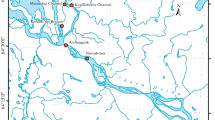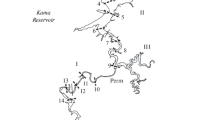Abstract
The drinking water reservoir Saidenbach (Germany) has been investigated continuously from the year 1975 onwards. Since 1987, daphnids (Daphnia galeata) — an essential component in the cycle of matter and energy in the pelagic zone of reservoirs and lakes — became less and less abundant. Its total and relative biomass declined drastically and the exponential population growth began later in the year. After 1990, also the biomass of the copepods decreased significantly. Thus, the total crustacean biomass declined from 0.35 cm3 m−3 (mean 1975–1990) to 0.22 cm3 m−3 in the 1990s. Top-down effects seem to be responsible for all these changes, because stocks of both native planktivorous fishes, mainly roach (Rutilus rutilus) and perch (Perca fluviatilis), and non-native silver carps (Hypophthalmichthys molitrix) have increased over the years. A second observation confirms this conclusion: the significant temperature effects on the growth rate of Daphnia observed every year in early summer (May) in the first years under investigation were not detectable anymore after the year 1987. Since then, the exponential population development did not start until end of June/beginning of July. This delay and the substantial decrease of the mean body length of the daphnids are clear indications for the enormous predation pressure on this zooplankton group. Simultaneously, the concentration of nanoplankton increased and the Secchi depth decreased indicating the diminishing impact of crustaceans on phytoplankton in the course of the years. Thus, a significant relationship between the concentration of Daphnia and the water transparency could be obtained — a confirmation of their great importance for the water clarity. Consequently, if Daphnia shall provide a positive contribution to water quality (e.g., by effective particle elimination), a well structured fish community with regard to species composition, size structure, standing stock and functional groups will be needed as a prerequisite.
Similar content being viewed by others
References
Benndorf, J., U. Kahl, R. J. Radke S. Worischka, 1999. Steigerung der Biofiltration durch Optimierung der Fischbesiedlung mit dem Ziel der Rohwasser-Voraufbereitung in Trinkwassertalsperren. Paper, TU Dresden, Institut für Hydrobiologie: 42 pp.
Benndorf, J., J. Kranich, T. Mehner A. Wagner, 2001. Temperature impact on the midsummer decline of Daphnia galeata: an analysis of long-term data from the biomanipulated Bautzen Reservoir (Germany). Freshwat. Biol. 46: 199–211.
Benndorf, J., B. Wissel, A. F. Sell, V. Hornig P. Ritter, 2000. Food web manipulation by extreme enhancement of piscivory: an invertebrate predator compensates for the effects of planktivorous fish on a plankton community. Limnologica 30: 235–245.
Blaustein, L. H. J. Dumont, 1990. Typhloplanid flatworms (Mesostoma and related genera): mechanisms of predation and evidence that they structure aquatic invertebrate communities. Hydrobiologia 198: 61–77.
Ewig, B. E. Hoehn, 2001. Auswirkungen der nordatlantischen Oszillation und kleinräumiger Klimavariationen auf die Planktonzukzession in der Trinkwassertalsperre Kleine Kinzig (Nordschwarzwald). DGL-Tagungsbericht 2000 Magdeburg, Tutzing: 703–706.
Flößner, D., 2000. Die Haplopoda und Cladocera Mitteleuropas. Backhuys Publishers, Leiden: 428 pp.
Gerten, D. R. Adrian, 2000. Climate driven changes in spring plankton dynamics and the sensitivity of shallow polymictic lakes to the North-Atlantic-Oscillation. Limnol. Oceanogr. 45: 1058–1066.
Horn, H., 2003. The relative importance of climate and nutrients in controlling phytoplankton growth in the Saidenbach Reservoir. Hydrobiologia 504: 159–166.
Horn, H., L. Paul W. Horn, 2001. Phytoplanktonzunahme trotz fallender P-Belastung – ein Widerspruch GWF 142: 268–278.
Horn, W., 2001. Die Entwicklung planktischer Crustaceen in der Talsperre Saidenbach über 25 Jahre – Trends und ihre Hintergründe. DGL-Tagungsbericht 2000 Magdeburg, Tutzing: 603–607.
Horn, W. H. Horn, 1995. Interrelationships between crustacean zooplankton and phytoplankton: results from 15 years of field observations at the mesotrophic Saidenbach Reservoir (Germany). Hydrobiologia 307: 231–238.
Horn, W., B. Koch H. Horn, 2002. Langzeitentwicklung des Rotatorienplanktons der Talsperre Saidenbach: Trends und Hintergründe. DGL-Tagungsbericht 2001 Kiel, Tutzing: 301–306.
Kahl, U., R. J. Radke J. Benndorf, 2002. Ausgangszustand einer Fischartengemeinschaft vor der Biomanipulation: Spezifische Bedingungen in einer tiefen mesotrophen Talsperre mit geringem Litoralanteil. DGL-Tagungsbericht 2001 Kiel, Tutzing: 324–329.
Paul, L., 2003. Nutrient elimination in pre-dams: results of longterm studies. Hydrobiologia 504: 289–295.
Radke, R. J. U. Kahl, 2002. Effects of a filter-feeding fish (silver carp, Hypophthalmichthys molitrix) on the structure of phytoand zooplankton in a mesotrophic lake: results from an enclosure experiment. Freshwat. Biol. 47: 2337–2344.
Schultz, H., 1983. Untersuchungen über die Größe und Struktur des Fischbestandes sowie den Nahrungskonsum ausgewählter Fischarten in zwei Stauseen unterschiedlichen Trophiegrades. Diss. A, TU Dresden: 141 pp.
Sommer, U., Z. M. Gliwicz, W. Lampert A. Duncan, 1986. The PEG-model of seasonal succession of planktonic events in fresh waters. Arch. Hydrobiol. 106: 433–471.
Straile, D. R. Adrian, 2000. The North Atlantic Oscillation and plankton dynamics in two European lakes – two variations on a general theme. Global Change Biol. 6: 1–8.
Author information
Authors and Affiliations
Rights and permissions
About this article
Cite this article
Horn, W. Long-term development of the crustacean plankton in the Saidenbach Reservoir (Germany) – changes, causes, consequences. Hydrobiologia 504, 185–192 (2003). https://doi.org/10.1023/B:HYDR.0000008518.30455.5e
Issue Date:
DOI: https://doi.org/10.1023/B:HYDR.0000008518.30455.5e




